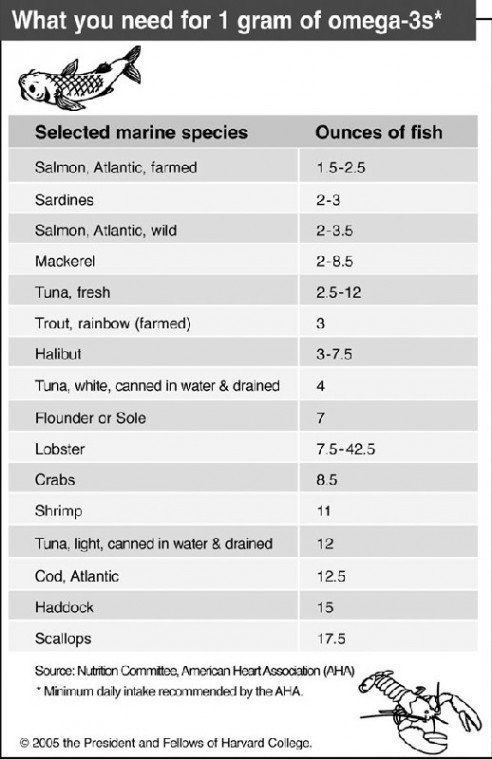Q: What types of fish are best for heart health? How much should
I eat? Should I be concerned about possible contaminants found in
farmed salmon or other fish?
Q: What types of fish are best for heart health? How much should I eat? Should I be concerned about possible contaminants found in farmed salmon or other fish?
A: For protecting your heart, doctors generally recommend oily, dark-fleshed fish such as salmon, sardines, mackerel and tuna (see table). These varieties are particularly rich in omega-3 fatty acids, special fats that help protect against disturbances in the heart’s pumping rhythm (called ventricular arrhythmias), which can be fatal.
Eating fish also appears to lower the risk of nonfatal heart attacks, strokes and atrial fibrillation, another heart-rhythm problem.
Although taking fish oil capsules also reduces your risk of heart disease, eating fish is your best bet. For one thing, fish contains other nutrients not found in fish oil, including selenium, various antioxidants and protein. Also, people who eat fish tend to eat less meat and cheese. And they may complement their fish with other healthful foods, such as vegetables and brown rice.
A recent long-term study found that the type of fish you eat really does make a difference. The study involved more than 3,900 men and women who were at least 65 years old.
In addition to undergoing a physical exam and standard heart tests, each volunteer gave a detailed diet history. The questionnaire included three different categories of fish: tuna (fresh, salad or casserole), other broiled or baked fish, and fried fish or fish sandwiches.
To see if the dietary histories reflected how much omega-3 they were eating, researchers checked the blood levels of omega-3s in a subset of the volunteers.
None of the subjects had heart disease when the study began. Over the next nine years, 247 people died from heart disease and another 363 suffered nonfatal heart attacks. In analyzing the results, researchers accounted for many factors, including age, gender, smoking, diabetes, cholesterol, obesity and blood pressure. They found that people who ate tuna and other baked or broiled fish enjoyed protection, but those who ate fish sandwiches or fried fish did not.
In all, people who ate tuna or other baked or broiled fish at least three times a week were about half as likely to die from heart disease than those who ate them less than once a month.
Most of the protection came from a lower risk of sudden death due to arrhythmias. Eating tuna or other baked or broiled fish just once a week helped, cutting the risk of death from heart disease by 27 percent.
A similar study found that people who ate tuna and other types of broiled or baked fish had a 30 percent lower risk of stroke. Those who ate fried fish saw no such benefit.
Were the people who ate fried fish or fish sandwiches not protected because of the frying or because of the specific fish used? They had low omega-3 blood levels because they ate pollock and cod, both of which are low in omega-3s. In fact, those who ate tuna and other baked or broiled fish had much higher omega-3 levels.
But what about the recent concerns about contaminants in fish? Fish absorb chemical pollution from the water where they live. The major concerns are methyl mercury and polychlorinated biphenyls (PCBs).
Mercury can damage the brain and nervous system in developing children, but it’s much less worrisome for adults. To reduce the risk of ingesting mercury, the Environmental Protection Agency and the Food and Drug Association recommend that young children and women who are pregnant or nursing avoid swordfish and other high-mercury species, such as king mackerel, shark and tilefish. They should also eat no more than 12 ounces of fish a week. The EPA also cautions against eating freshwater fish from lakes and rivers that are under fishing advisories because of industrial pollution.
Farmed fish have little mercury, but they may have PCBs. PCBs and other contaminants enter water from industrial pollution. The EPA banned PCBs in 1977, calling them a “probable human carcinogen.” But these durable chemicals have lingered in the environment for decades.
Last year, several reports raised alarms about PCBs in farmed salmon. Farmed salmon harbors nearly eight times more PCBs than wild salmon. But most of the farmed salmon sold in the United States contains only trace amounts of PCBs – about 2 percent of the 2,000 parts per billion that the FDA considers safe.
Still, the EPA advises people to eat no more than 8 ounces of farmed salmon per month. For wild salmon, the recommended limit is 64 ounces a month. Removing the skin and fat before cooking can help lower PCB exposure.
But overall, eating fish can offer a net gain for your health. Two to three modest portions a week – with an emphasis on fish high in omega-3s – will do the job.
Submit questions to the Harvard Medical School Adviser at www.health.harvard.
edu/adviser. Unfortunately, personal responses are not possible.













